Released last November, Viet Su Dien Hoa (Illustrated Book of Vietnamese History) is a 208-page comic that summarizes Vietnam’s 4000-year history until 1945, when the last feudal dynasty ended. After the book was introduced on the Comicola Facebook fanpage for Vietnamese comic lovers, it attracted 1.5 million likes and positive comments like “The book cover is so beautiful” and “It sounds appealing right from the title, please let me know when it is available for pre-order”.
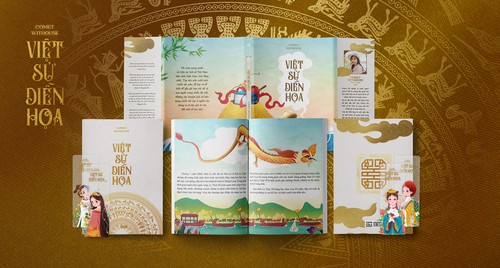 Viet Su Dien Hoa (Photo: Comicola) Viet Su Dien Hoa (Photo: Comicola) |
The author, 28-year-old Hanoian Dang Thanh Huyen, is a member of Dai Viet Co Phong, a history and culture club for young Vietnamese. Huyen said many people wondered how she could condense 4,000 years of history into 208 pages. She, too, thought it was impossible in the beginning. “I decided to include only the main events and use pictures to make it easier for the readers to understand," Huyen said, "For example, all the stories about the different generations of the Tran dynasty I compacted into three main stories: the building period, the prosperous period, and the decline, all in 2 pages. I started researching Vietnam’s history 3 or 4 years ago. Sometimes I had to retell stories in the light of my own understanding so that even children and readers not so interested in history could get the idea.”
 Author Dang Thanh Huyen Author Dang Thanh Huyen |
Huyen chose the most significant stories and most dramatic details, retold them in an accessible way, and rendered them in colorful, detailed pictures. The idea of producing an epic comic first occurred to her in October 2019, but it wasn’t until March 2020, when the COVID-19 pandemic forced her to stay home for several months, that she was able to turn the idea into reality. Between March and June, Huyen spent up to 12 hours a day writing and illustrating the draft of her comic book. During that time, she drew 100 pictures illustrating 68 1- or 2-page stories. For example, the story about the Au Lac kingdom is covered in 2 pages, the first of which is about King An Duong Vuong building the kingdom, and the second about My Nuong marrying Trong Thuy, which led to the kingdom’s downfall.
Rather than conversations occurring between the characters, the stories are told by an unseen narrator. Huyen focused on recreating Vietnam’s ancient royal costumes, architecture, decorations, and weapons so readers can see how glorious Vietnam was in different historical periods. She told VOV: “My passion is drawing the queens and concubines’ costumes. I think they are very beautiful. I added some decorative patterns to the costumes that are based on my understanding of each historical era. I think interesting pictures attract readers, but the text must be interesting, too.”
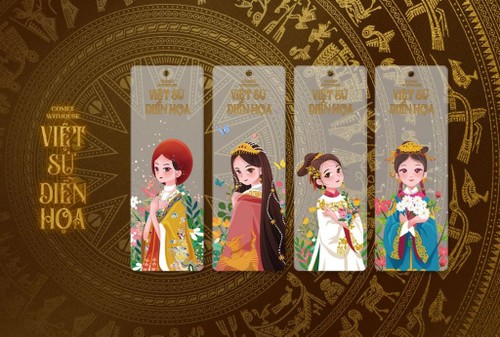 Huyen's illustrations of Vietnamese queens and concubines in different periods of history (Photo: Comicola) Huyen's illustrations of Vietnamese queens and concubines in different periods of history (Photo: Comicola) |
An illustrated history book that contains hundreds of historical characters could hardly avoid some speculation about their exact appearance or manner. There is a scarcity of historical sources today, as much of it was lost during Vietnam’s wars. Thanh Huyen says she expected some criticism and complaints, but decided to go ahead with the project because it satisfied a great passion of hers.
After finishing the book, Huyen showed it to Comicola, a publishing company that encourages young Vietnamese artists. Director Nguyen Khanh Duong is also a member of Dai Viet Co Phong and has worked with Huyen for a long time. He said: “I had a high opinion of Huyen from previous impressive work she’s done. Six months ago when she brought the draft of her book to me, I was surprised and very pleased. I and several other editors worked with her and gave her ideas for some changes to make the book look even better and make sure it is historically accurate and suitable for young readers.”
Viet Su Dien Hoa became a team effort. The paper, ink colors, page design, and even bookmarks were discussed carefully by the team to maximize the readers’ enjoyment. The team raised development money through crowdfunding, the practice of funding a project or venture by collecting small amounts of money from a large number of people, via the Internet. Crowdfunding first appeared in the US in 2010 and is now considered the most effective way for unknown authors to get their work out to the public. “The best thing about crowdfunding is that it helps young authors evaluate their work," Duong said, "They don’t need to pay for printing 3,000 copies. They just have to post some good pictures on Facebook to attract investors. If the public responds to their idea, it gives them the confidence to turn it into a real product. If not, they can halt the project without losing much money. It’s much safer. We decided to start with crowdfunding because big publishing houses don’t seem to be very interested in young authors’ work and there isn’t a strong comic industry in Vietnam. Thanks to crowdfunding, we’ve been able to develop and support some artists.”
In the future, Huyen hopes to develop a computer game based on Vietnamese culture and history to promote a love of history among young people.
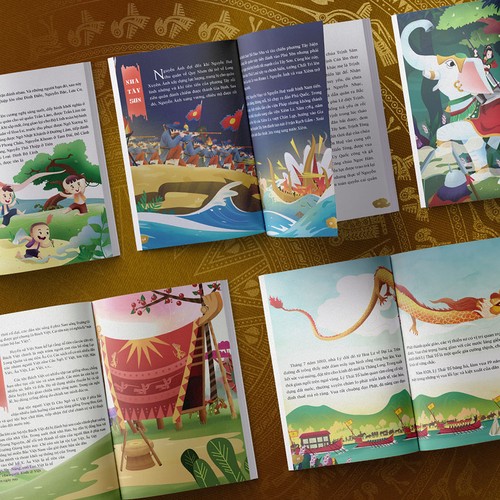 Viet Su Dien Hoa is a team effort (Photo: Comicola) Viet Su Dien Hoa is a team effort (Photo: Comicola) |
Woodcut is a kind of traditional graphic design technique that appeared in Vietnam at almost the same time as the worship of ancestors and the deification of natural phenomena. There used to be a number of craft villages of skilled woodcut artisans in Vietnam, such as Dong Ho, Hang Trong, and Kim Hoang from the 16th to the 20th century. To keep the art alive, woodcut has been made part of the curriculum of art schools in Vietnam. Ms. Pham Duyen, a lecturer at the University of Industrial Fine Art, said: “Woodcut is part of the graphic design program at our university. Our main goal is to teach students to develop their graphic depiction techniques, structures, and colors, and learn how to carve on a woodblock.”
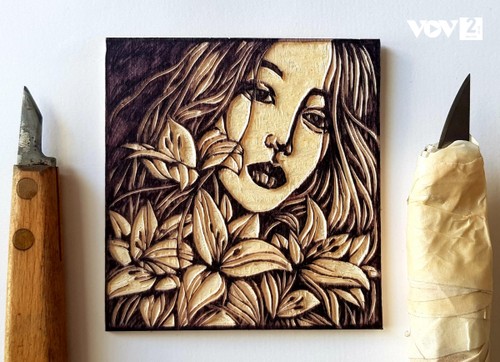 A woodcut painting A woodcut painting |
For some traditional arts, such as oil-on-canvas or lacquer, the artists only need to concern themselves with colors and materials. But for woodcut, the first thing that every artist must do is create wood models. Almost any common wood material can be used to make a model. After that, the artist will use different types of chisels to carve the woodblock to create the desired images. Artisans in the past carved wood manually, but today they can take advantage of modern tools such as milling machines, power saws, lasers, and computer numerical control (CNC) to make a model. After the carving comes the coloring. Truong Thanh Long, a student at the University of Industrial Fine Art, said: “We use the same offset ink used for newspaper printing. The difference is that we use a roller to color the woodcut. We first make a color sketch using Photoshop, then mix different colors of ink together and put the mixture into the roller. For Dong Ho folk paintings, artisans could work with only one color at a time, but for modern woodcut paintings, we can use multiple colors, so the offset ink is good because it dries very fast.”
The last step of making a woodcut painting is to press water absorbing paper onto the wood model. A separate model must be made for each color in the picture. Long showed us one of his works – a vase with a pink lotus in it on a table containing various fruits. “In this painting, you can see shades of brown, green, and yellow," he said, "That means I had to use one model for the yellow, and another one for the brown. I made a large area of brown, then carved away the unneeded parts based on the design.”
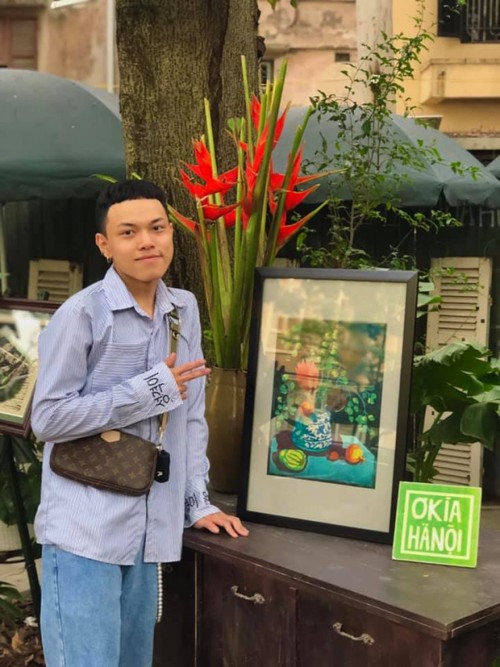 Truong Thanh Long introduces his woodcut painting (Photo: VOV) Truong Thanh Long introduces his woodcut painting (Photo: VOV) |
Art students’ woodcut paintings are periodically displayed at workshops at the University of Industrial Fine Art, and attract quite a few visitors. Dang Van Hung from Hai Duong said: “I was very impressed with the paintings. They are beautiful with subtle shades of color.”
In addition to upholding Vietnamese traditional arts, woodcuts can be very practical. They have been used to print money, stamps, and book covers.